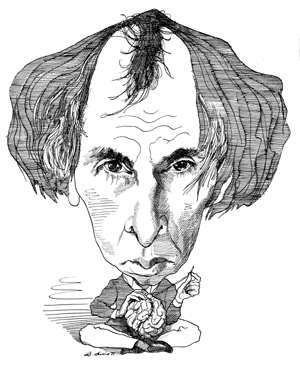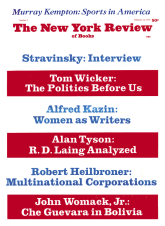In theory the publication of a substantially revised edition of R. D. Laing’s The Self and Others, and the reissue of his first and I suppose still most celebrated book, The Divided Self, now more than ten years old, should provide as good an occasion as any for a retrospective survey of his work and an attempt at a critical assessment. But in practice this seems both difficult and discouraging.
Why is that? It is not as though reading Laing is discouraging or uncongenial. He is an attractive, even seductive writer—a point to which I shall return, since it calls for closer examination. In England The Divided Self must be counted as the most widely known of all recent psychiatric writing, popular or specialist; and although paperback psychiatry—I use the phrase as a loose categorization, not as a disparagement—is a much more highly developed genre in the States (where Laing’s works have had to compete with the productions of writers as varied as Norman O. Brown, Eric Berne, Erich Fromm, Hannah Green, and Ken Kesey), the recent Politics of Experience has probably reached a wider readership than any.
Wider, but not necessarily broader. It seems a rather curious readership. For Laing, as everyone knows, has become a cult figure; and this fact imposes on the reviewer of his books a burden not merely of trying to understand the points that Laing is making, and of testing them against his own judgment and experience, but of attempting to discover the basis of their appeal to people not otherwise apparently interested in psychiatric theory.
Commentators on Laing frequently lump his writings together, as if each book were saying much the same thing, or at any rate as if the basic message were homogeneous. By doing so they indicate that they must have a high tolerance of inconsistency. Perhaps an approach of that kind has advantages; those who are very squeamish about inconsistencies will not expect to get much from Laing,
This Issue
February 11, 1971
-
1
Cf. Siegler, Osmond, and Mann, “Laing’s Models of Madness,” British Journal of Psychiatry (1969), vol. 115, pp. 947-58. It is a matter for regret that the authors should have chosen the loosely written Politics of Experience for their theoretical scrutiny rather than, for instance, The Divided Self.
↩ -
2
“Seen as an organism, man cannot be anything else but a complex of things, of its, and the processes that ultimately comprise an organism are it-processes. There is a common illusion that one somehow increases one’s understanding of a person if one can translate a personal understanding of him into the impersonal terms of a sequence or system of it-processes.” (The Divided Self, p. 21)
↩ -
3
Cf., for example, William I. Grossman and Bennett Simon, “Anthropomorphism: Motive, Meaning, and Causality,” Psychoanalytic Study of the Child (1969), vol. 24, pp. 78-111.
↩ -
4
It strikes me as a maneuver not dissimilar to a current attempt to extend the word “obscene” (as in “the war in Vietnam is obscene”).
↩ -
5
This is naturally reflected in a wide range of views on the best treatment and management, or self-management, of people whose behavior and experiences invite their being labeled as schizophrenic. Searles’s 1959 paper, already referred to, is subtitled “An element in the etiology and psychotherapy of schizophrenia”; but in the books by Laing that I have read I have found very little concerning techniques for restoring the integrity of the divided personality, or for countermanding the malign influence of disordered family praxis, or for evading the alienating effects of Western society, or for getting unknotted.—Cf. however the moving account of Mary Barnes’s experiences at Kingsley Hall (an experiment in communal living sponsored in part by Laing) in The Atlantic Monthly, January, 1971.
↩






